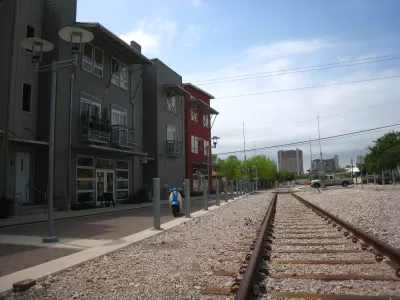Changes to the criteria for evaluating applications for the federal New Starts program could have a significant impact on efforts to preserve and expand affordable housing in close proximity to transit.

As cities across the country build new transit systems, many are struggling to prevent rising rents in areas near stops from displacing lower-income residents. Jeffrey Lubell looks at a little noticed federal policy change that could help mitigate transit-oriented gentrification.
"The new federal policy is one that, for the first time, provides tangible financial incentives for local communities to preserve affordable housing near planned transit stations and ensure that any new development in these areas includes housing affordable to low- and moderate-income households."
"The new incentives come through changes to the criteria for awarding federal New Starts grants for new and expanded public transit lines to give extra points in the 'economic development' section of the competition to communities that adopt and implement housing policies to achieve these goals," he explains. "The new policy also creates incentives in the 'land use' section of the competition for communities to choose transit alignments that serve neighborhoods that include subsidized housing."
"It remains to be seen how this new policy plays out in practice," adds Lubell. "Will applicants for New Starts grants work collaboratively with local stakeholders to develop creative, effective and comprehensive strategies for housing inclusion? Or will they simply describe existing (and largely insufficient and disconnected) housing efforts in glowing terms and hope they get the full score? And will the reviewers scoring the applications be able to tell the difference?"
FULL STORY: Could Transportation Policy Transform Affordable Housing?

Alabama: Trump Terminates Settlements for Black Communities Harmed By Raw Sewage
Trump deemed the landmark civil rights agreement “illegal DEI and environmental justice policy.”

Planetizen Federal Action Tracker
A weekly monitor of how Trump’s orders and actions are impacting planners and planning in America.

The 120 Year Old Tiny Home Villages That Sheltered San Francisco’s Earthquake Refugees
More than a century ago, San Francisco mobilized to house thousands of residents displaced by the 1906 earthquake. Could their strategy offer a model for the present?

Ken Jennings Launches Transit Web Series
The Jeopardy champ wants you to ride public transit.

BLM To Rescind Public Lands Rule
The change will downgrade conservation, once again putting federal land at risk for mining and other extractive uses.

Indy Neighborhood Group Builds Temporary Multi-Use Path
Community members, aided in part by funding from the city, repurposed a vehicle lane to create a protected bike and pedestrian path for the summer season.
Urban Design for Planners 1: Software Tools
This six-course series explores essential urban design concepts using open source software and equips planners with the tools they need to participate fully in the urban design process.
Planning for Universal Design
Learn the tools for implementing Universal Design in planning regulations.
Clanton & Associates, Inc.
Jessamine County Fiscal Court
Institute for Housing and Urban Development Studies (IHS)
City of Grandview
Harvard GSD Executive Education
Toledo-Lucas County Plan Commissions
Salt Lake City
NYU Wagner Graduate School of Public Service




























